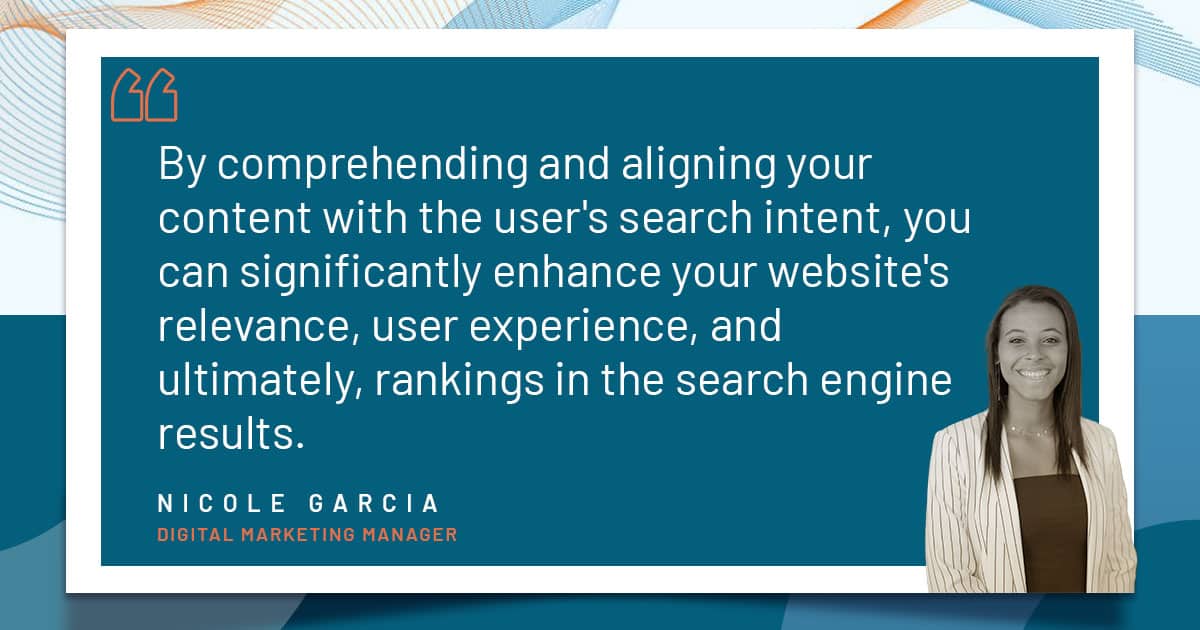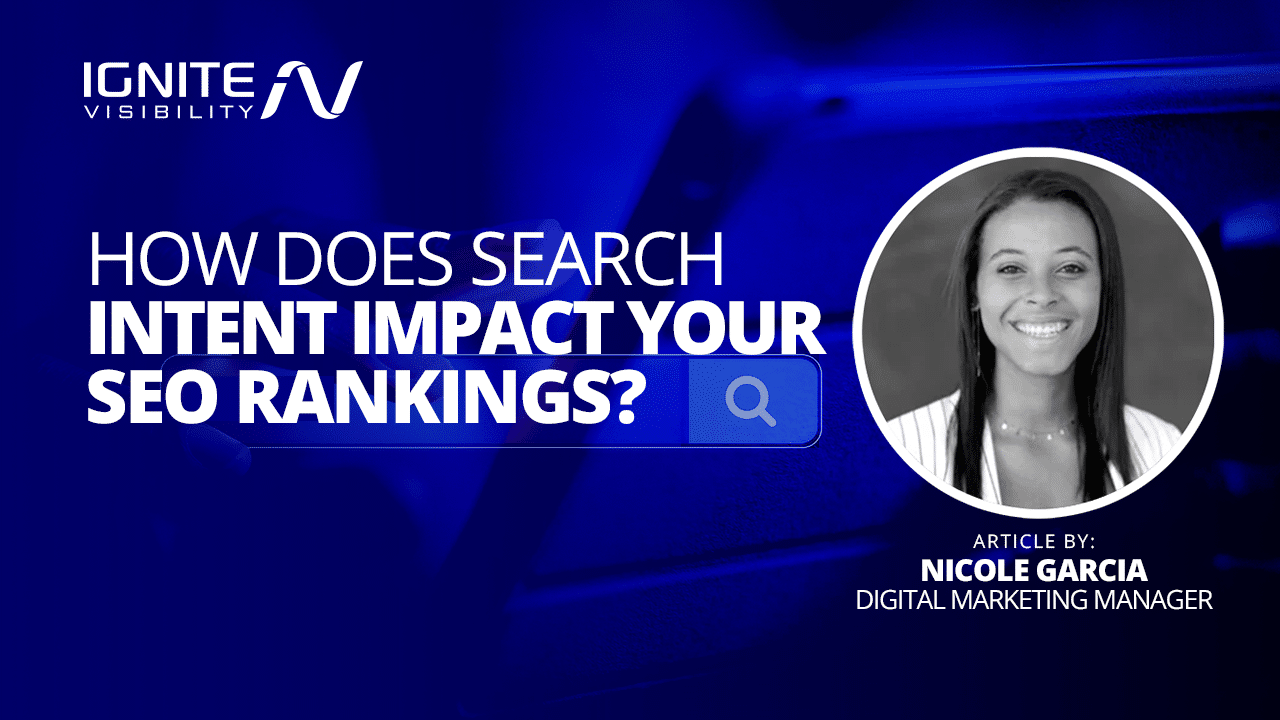
The phrase “Google it” has become increasingly popular over the last decade, as the search engine has solidified its position as the go-to source for instant information.
But behind this simple phrase, lies search intent.
What You’ll Learn
- What is Search Intent?
- Search Intent vs. Search Query vs. Keywords
- What Does Search Intent Affect?
- 4 Types of Search Queries and How to Target Each
- Tools to Help You Decipher Search Intent
- FAQs: Search Intent
What is Search Intent – And Why Does it Make a Difference for SEO?
While keywords are the actual words that go into a search query, there’s a deeper meaning behind that press of the enter button.
Put simply, search intent refers to someone’s goals when entering search queries into Google and other search engines.
Keyword intent has been in the limelight for a while, but it really came into focus with the launch of Google’s BERT algorithm. This update focuses on natural-language processing through the use of RankBrain, the company’s first-ever AI for search queries.
Google’s increasing emphasis on search intent ultimately translates to a better user experience for folks behind the keyboard. So, your goal when creating content is to target a searcher’s intent at every stage of the buyer’s journey.
In turn, you’ll see higher rankings, resulting in more sales and a reduced bounce rate as more people find your content helpful and relevant.
In this blog, I’ll take you through a dive deep into search intent, the types of search intent, and how you can optimize your SEO strategy.
Our Expert’s Insight on Search Intent
Our Digital Marketing Manager, Nicole Garcia, says, “Understanding search intent is crucial for any digital marketing strategy, especially in the realm of SEO. Search intent refers to the purpose behind a user’s query on a search engine. By comprehending and aligning your content with this intent, you can significantly enhance your website’s relevance, user experience, and ultimately, its ranking on search engines.”
Search Intent vs. Search Query vs. Keywords
When going into SEO and how search intent fits into it, it’s important to know the difference between this concept and its components.
Search Intent
Search intent specifically refers to what users want when they search for something online. Do they want to learn more about a given topic? Maybe they’re looking for a potential solution to a problem. Search intent will inform the kind of terms they enter into search engines.
Search Query
Search queries are the specific phrases that people enter based on their intent. They can include full sentences or a couple of key terms with broader intent. Sometimes they are even questions.
The query the person enters will depend on what they want to achieve with the search, whether it’s information or help with making a decision.
Keywords
At the lowest level below queries and intent are keywords, which factor into search queries. You can classify keywords based on length more than intent, with short-tail keywords consisting of one to two works, while long-tail keywords get more specific with three or more words.
Often, long-tail keywords tend to make up search queries with a clear intent behind them. For example, someone intent on buying new shoes might enter something like “new black [brand name] shoes for sale,” which would be a long-tail branded keyword doubling as a search query with the intent to buy.
What Does Search Intent Affect?
Search intent plays an important role in optimizing content for search engines in a few main ways. The following are some of the elements of the search experience that search intent impacts, which ultimately affects your SEO strategy and website rankings.
1. The Google Algorithm
Google regularly updates its algorithm to deliver the ideal experience to its users. In doing so, the algorithm increasingly appeals to people’s search intent, delivering them the most relevant results.
Google’s most recent core algorithm update was in early November of 2023, bringing minor changes that won’t likely impact many high-quality websites. Google advises that as long as people are creating people-centric and helpful content, the core update shouldn’t negatively impact them.
In conjunction with this core update, Google rolled out another update to review and opinion-based content based on its quality guidelines.
Past updates have also aimed to weed out spammy content that’s simply optimizing for keywords and not search intent. Over the years, search results have subsequently become more valuable to users, since Google’s main goal is to deliver highly relevant, quality content to satisfy searcher intent.
2. Artificial Intelligence (AI)
Artificial intelligence and machine learning have come a long way in optimizing online experiences of all kinds, and search engines are no exception.
As people conduct searches on Google and other platforms, AI learns from users’ input and behavior to determine what kinds of content they want. In the process, Google can fine-tune results to ensure they’re of the highest relevance based on user intent.
3. SERP Experience
The overall search engine results page (SERP) experience undergoes changes based on what people want.
Often, this applies to trending topics. For example, when the film Oppenheimer was released earlier this year, more search results revolved around the film rather than its subject, J. Robert Oppenheimer.
Additionally, search engines include certain features to connect with audiences at different stages of their journey. An example of this would be a Knowledge Panel that summarizes information about a specific subject in a bite-sized, convenient format or as a Rich Result, providing extra visual or interactive features.
4 Types of Search Queries & How to Target Each One
With a better idea of what search intent is, you should know about the different types of search queries, based on the intent behind them. You can then determine how to optimize search intent targeting to perfect your SEO strategy.
1. Informational (Know)
- Type of Search Query: Informational
- Searcher’s Intent: To learn something
- Search Terms: “What is,” “How to,” “Who is,” “Where did,” and “Why is”
- Content Ideas: Guides, tutorials, resources,Ideas, Tips and Examples
At the beginning of the buyer’s journey, people want to learn about problems they’re having or the products they might need. They’ll enter informational search queries into search engines during this phase to know more.
You need a strong content strategy that provides a solid user experience and answers top-level questions. Avoid simply stuffing keywords into content. Instead, provide meaningful info for customers in need of help.
Pro Tip: Try to rank for Featured Snippets at this level. Snippets are highlighted sections of content that appear right in the middle of search results, and they can immediately grab people’s attention over generic results.
As an example, consider potential patients in the healthcare and dental industries. People at this stage will want to learn more about symptoms and conditions they may be experiencing. To target these people, you’ll want to rank for queries like “What condition causes [symptom]” or “Why does my tooth hurt?”
Having a blog rich with this information can hook prospective patients and establish you as a worthwhile authority and knowledge leader. As potential patients continue their journey, they’re more likely to come back to you because of the wealth of info you provide.

Example of an Informational Search Query
2. Navigational (Go)
- Type of Search Query: Navigational
- Searcher’s Intent: To go somewhere
- Search Terms: Brand names, product names, service names
- Content Ideas: Company-branded content like contracts, policies, terms and conditions
At this stage of the customer journey, people are looking for a particular source to research, whether it’s a website, app, or service from one or more brands.
The person may have an idea of what to look for, including the specific website, but uses search engines to simplify things over entering a URL into their browser’s address bar.
This stage can present a challenge for businesses to rank in search. To appear in front of users with this search intent, it’s best to own the brand that people are entering in search queries.
For instance, if you own an automotive company, people near your locations might search “[your brand] automotive parts” or “[your brand] auto repair.”
At this point, you would want to focus more on the optimization of branded and other “go” keywords that help you appear in organic results. Not only would this involve SEO, but you would also want to bid on valuable navigational terms in PPC ad campaigns to get on top.
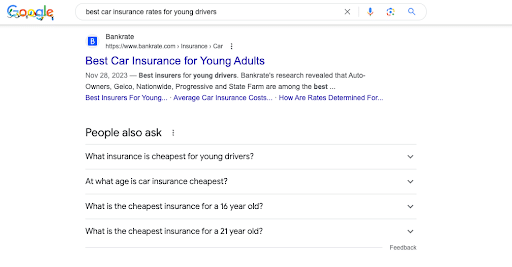
Example of a Navigational Search Query for Jiffy Lube
3. Commercial (Do)
- Type of Search Query: Commercial
- Searcher’s Intent: To seek out further information
- Search Terms: “Best,” “Top”
- Content Ideas: Reviews, product comparisons, product attributes
As people approach the bottom of the funnel (BOFU) and prepare to make a buying decision, they’ll reach the transactional stage in their searches.
These users are interested in what you have to offer but want to learn more before committing to a purchase. In other words, they’re at the consideration stage of the buyer’s journey and getting closer to the decision stage.
Some of the key terms that people will search at this point include modifiers like “best,” “top,” “alternative,” and “reviews for.”
As with navigational campaigns, you’ll want to supplement SEO efforts with PPC ads at this stage.
To give you an idea of what this would look like, let’s consider how an insurance company might approach this strategy. At this stage, people might be comparing insurers and enter keywords like “best auto insurance rates” or “reviews of [insurance company].” The insurance company would create landing pages highlighting why their insurance is affordable and reliable compared to competitors, with ads targeting these and other transactional terms.
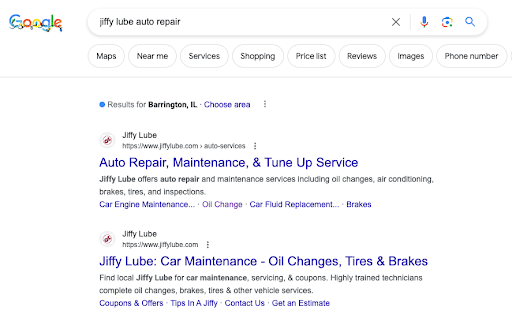
Commercial Search Intent Example – Buying Car Insurance
4. Transactional (Buy)
- Type of Search Query: Transactional
- Searcher’s Intent: To buy a product or service
- Search Terms: “Buy,” “Purchase,” “Near me ___” “Town/City and (type of merchant)
- Content Ideas: Coupon or discount code
When search engine users reach this point, they’re ready to buy and commit to a brand.
People at this point might enter terms like “buy [product]” or “best deal on [product].” They know what they want, and they want it now.
During this BOFU stage, you’ll want to ensure products and landing pages are fully optimized with action keywords. In your efforts, you should also optimize for technical SEO using Schema.org markup. This structural data gives search engines more context as to what your pages are about, indicating whether you have items like:
- Product availability
- Limited-time offers
- Images and videos
- Reviews, ratings, and FAQs
For example, a home services company might target terms such as “schedule HVAC services near me” or “[brand] plumbing services in [town].” They’re ready to get the services they need and know what kind of issue they’re experiencing.

Transactional Search Query Example
Tools to Help You Decipher Search Intent
Want to master your SEO strategies by targeting the best intent-driven search queries? Here are some helpful tools that you can use to optimize your campaigns.
1. Google Ads
One of the most essential tools for marketers is Google Ads, which enables you to easily set up PPC ad campaigns and get on top of search results. Find the right keywords to bid on based on search intent for PPC while also picking keywords for SEO.
2. Featured Snippets
Using structured data like schema markup on your web pages, you can optimize for Featured Snippets on Google. These are paragraph-long excerpts that people would see when searching, ideally during the informational stage of the buyer’s journey.
Here’s an example of a snippet people would see when learning more about a specific car problem:
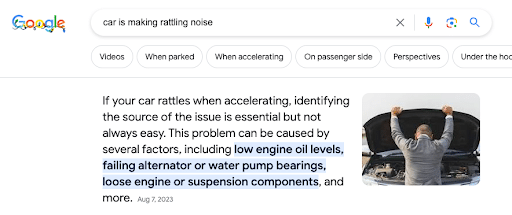
Example of a Featured Snippet
3. People Also Ask
Answering FAQs on your page and indicating them with schema markup on your website could help you rank for Google’s “People Also Ask,” which is an FAQ section of results with drop-down paragraphs answering various related questions.
Looking at this section when conducting your searches can also help with finding new keywords to target that you might have overlooked.
Stemming from the above Featured Snippets example relating to car troubles, the person could also see this section below:
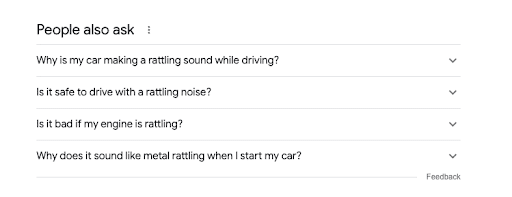
Example of People Also Asked
4. Local SEO Analysis
Another method you can use to optimize search queries is local SEO analysis. You can use keyword research tools to find popular locally targeted keywords, which people will most likely enter during the commercial or transactional phase of the buyer’s journey.
In addition to using the best keyword tools like Google’s Keyword Planner to conduct local analysis, you can simply enter related terms like “home services in [city]” and see what kinds of results pop up. What are your competitors doing to get on top of these searches?
5. SERP Ranking Analysis
Take a look at some of the top-ranking pages your competitors are getting for different types of search intent.
You can do so by simply entering popular terms with different intents and seeing which pages are on top. Analyze these pages using SEO checker tools or by manually reviewing them, and see what steps they’re taking to maximize visibility.
Consider what keywords they’re using and how along with the specific content these pages feature. From there, you can determine how to optimize your pages to perform better in SERPs.
FAQs About Search Intent
Want more information about search intent and how to target it? Check out our FAQs below.
1. How does search intent impact click-through rates (CTR)?
Generally, appealing to searcher intent and getting on top of search results will lead to higher CTR. However, people are more likely to click through terms that are long-tail and branded over broader short-tail keywords. Also, the CTR will vary based on the industry.
2. What other tools can help me identify search intent for specific queries?
Multiple tools exist to help analyze search intent based on particular queries, including:
- Google Search Console, where you can use tools like Search Analytics and Performance Reports
- SEMrush, which offers features like the Content Analyzer and Keyword Gap Analysis
- Ahrefs, with features like the Keyword Explorer and Content Gap
3. How does search intent vary across different industries?
Depending on your industry, the nature of search queries will vary. For instance, if people are interested in a big investment like a new vehicle, they’ll likely want to do a lot more research. As a result, they’ll spend more time in the informational and commercial stages before getting into navigational and transactional intent.
Conversely, industries like ecommerce may see more search intent in the transactional and navigational areas where people are ready to purchase shortly after researching different products.
4. How do long-tail keywords play into the search intent equation?
Typically, when targeting for searcher intent, you’ll want to optimize for long-tail keywords overbroad, short-tail terms. The reason for this is that people tend to get very specific with their searches when looking for more information, seeking comparisons, and making buying decisions.
5. What are the common mistakes to avoid while targeting search intent?
Some common mistakes that marketers make with search intent targeting include:
- Targeting short-tail keywords that are too broad
- Neglecting to perform in-depth keyword research and analysis
- Focusing more on the brand over the customer experience
- Emphasizing keywords over user experience and content quality
6. How can I measure the effectiveness of a search intent-focused campaign?
When you’re gauging the success of campaigns focusing on search intent, you’ll want to look at certain key metrics, including:
- Click-through rates
- Bounce rates
- Time on page
- Conversion rates
7. How can semantic search improve search engine targeting?
By targeting people’s intent with SEO and PPC, you can maximize your website’s visibility and relevancy, ensuring you’re at the forefront of people’s searches across the buyer’s journey.
Target Search Intent Correctly With the Help of Ignite Visibility
If you want to succeed with SEO and PPC campaigns by targeting search intent, Ignite Visibility is here to help.
We offer SEO, PPC, and other comprehensive digital marketing solutions for customers across a range of industries, including healthcare, dental, finance, automotive, insurance, and home services industries.
Based on your unique needs, we can:
- Conduct a thorough analysis to find the right keywords based on your target searcher’s intent
- Develop high-quality optimized content that connects with audiences
- Map the customer journey and establish effective touchpoints throughout
- Help you get the most from your marketing campaigns
- And more
To learn more about what we can do for you and to get started on a campaign today, reach out to us, and we’ll connect you with an expert.


